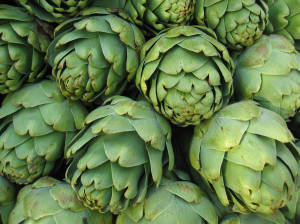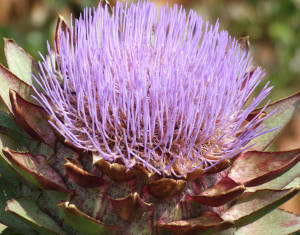Artichoke is an edible bud that is actually a species of thistle. The edible portion of the plant is the bud that forms before flowering. The flowered plant is inedible. The artichoke itself is divided in to a few different pieces, with the artichoke heart being the best bit. The core of the stem is also delicious. Many an inexperienced diner has mistaken artichoke heart with some sort of marine animal’s organ.
Artichokes do best in cool and dry locations. Temperate and Mediterranean climates are ideal. They do not do well at all in warm tropical areas, but attentive gardeners may be able to manage in sub-tropical areas
Planting Artichokes
Artichokes like well-drained soil that is a little on the sandy side. If it’s especially dry, dig in organic matter a month or two before planting. Artichokes are more particular about soil than many other edible plants, as they simply will not tolerate soggy soil. pH is best between 6.5 and 7.5, so lime the soil if necessary.
Growing artichokes from seed is the most popular way to do it. Timing of plantation varies depending on the climate, but they dislike muggy warm temperatures and frost. Early spring is a good time in many areas.
Sow seed one inch deep (2.5cm) in rows a foot (30cm) apart. Once they start to grow they will need to be transplanted so they are about a yard (90cm) apart, or you can thin them instead.
Artichokes can also be grown from ‘suckers’, which are the stems that grow off to the side from the base of the plant – in other words, the stems that aren’t the main stems. They can be removed from the main plant by using a spade to chop them off. Then, remove all old foliage and dry roots, and plant again! This is a great way to expand your artichoke crop. Plant them about 4 feet (120cm) apart with 5 feet (150cm) in between rows. You can sometimes buy suckers from the local store.
Growing Artichokes
It can take a while for artichokes to reach maturity, sometimes two seasons. In the initial period of growth they do not like too much sunlight, so a man-made shade may be necessary. The fertilizer of choice should be high in potash – they absolutely love the stuff. I like to fertilize every week or so.
Weed regularly and mulch with an organic matter such as sheep’s manure. If the weather gets frosty, protect your plants by covering with straw.
Harvesting Artichokes
Harvesting can be very quick if growing from suckers – a matter of 3 or 4 months. The buds are best harvested early in the season, when the scales are still tightly closed. Use a knife to slice two inches (5cm) below the bud.
Artichokes are perennial plants, meaning that it will live on and continue to produce. To ensure its produce remains large, do not let artichokes mature in to full flowers. I’m always tempted to do this anyway, as they are a magnificent flower.
The artichoke bud at the top of the main stem will develop first, followed by the side stems. This is convenient as it provides a continuous yield. Once all have been harvested, you can cut the plant down to the ground, cover it with a thick layer of mulch to protect it, and wait for next season when it will grow again.
Threats to Artichokes
Aphids and slugs are commonly found trying to nibble on artichokes. Use a pesticide for aphids, or use a garlic spray or just drench the plant with water from a hose to kill them off. Use slug pellets or traps for slugs. Fungal diseases happen occasionally, especially in sub-tropical climates. Use a fungicide, or try an organic solution if so inclined.


